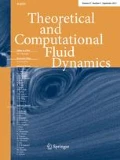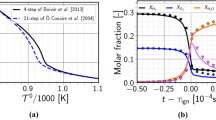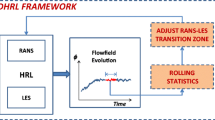Abstract
This report provides an assessment of current turbulent flow calculation methods for hypersonic propulsion flowpaths, particularly the scramjet engine. Emphasis is placed on Reynolds-averaged Navier–Stokes (RANS) methods, but some discussion of newer methods such as large eddy simulation (LES) is also provided. The report is organized by considering technical issues throughout the scramjet-powered vehicle flowpath, including laminar-to-turbulent boundary layer transition, shock wave/turbulent boundary layer interactions, scalar transport modeling (specifically the significance of turbulent Prandtl and Schmidt numbers), and compressible mixing. Unit problems are primarily used to conduct the assessment. In the combustor, results from calculations of a direct connect supersonic combustion experiment are also used to address the effects of turbulence model selection and in particular settings for the turbulent Prandtl and Schmidt numbers. It is concluded that RANS turbulence modeling shortfalls are still a major limitation to the accuracy of hypersonic propulsion simulations, whether considering individual components or an overall system. Newer methods such as LES-based techniques may be promising, but are not yet at a maturity to be used routinely by the hypersonic propulsion community. The need for fundamental experiments to provide data for turbulence model development and validation is discussed.
Similar content being viewed by others
Abbreviations
- C f :
-
Skin friction coefficient
- C p :
-
Specific heat at constant pressure
- d :
-
Distance from wall
- D :
-
Nozzle exit diameter
- D t :
-
Turbulent species diffusivity
- h :
-
Static enthalpy
- H :
-
Fuel injector ramp height for scramjet test case
- k :
-
Turbulent kinetic energy
- k t :
-
Turbulent thermal conductivity
- K :
-
Pressure gradient parameter
- M :
-
Mach number
- M t :
-
Turbulent Mach number
- P :
-
Static pressure
- \({\mathcal{P}_k}\) :
-
Production of turbulent kinetic energy
- \({\dot{q}_{w}}\) :
-
Rate of wall heat flux
- Pr t :
-
Turbulent Prandtl number
- R y :
-
Turbulent Reynolds number based on wall distance = \({\rho y \sqrt{k}/\mu}\)
- R t :
-
Turbulent Reynolds number = \({\rho k/\mu \omega}\)
- Re x :
-
Plate Reynolds number
- \({Re_{\nu}}\) :
-
Vorticity-based Reynolds number = \({\rho y^{2}\Omega/\mu}\)
- s :
-
Streamline coordinate
- S ij :
-
Rate of strain tensor
- Sc t :
-
Turbulent Schmidt number
- St :
-
Stanton number
- t :
-
Time
- T :
-
Static temperature
- T r :
-
Temperature ratio
- T t :
-
Stagnation temperature
- T w :
-
Wall static temperature
- U j :
-
Velocity vector
- U ∞ :
-
Freestream velocity
- W ij :
-
Vorticity tensor
- x, y, z :
-
Cartesian coordinates
- y + :
-
Wall normal coordinate
- \({\epsilon}\) :
-
Turbulent dissipation rate
- \({\epsilon_s}\) :
-
Solenoidal turbulent dissipation rate
- \({\mu}\) :
-
Dynamic viscosity
- \({\mu_t}\) :
-
Dynamic eddy viscosity
- \({\omega}\) :
-
Specific turbulent dissipation rate = \({\epsilon/\beta^{*}k}\)
- \({\Omega}\) :
-
Vorticity magnitude
- \({\phi}\) :
-
Fuel equivalence ratio
- \({\rho}\) :
-
Density
- \({\rho_{\infty}}\) :
-
Freestream density
- \({\tau^{T}_{ij}}\) :
-
Turbulent stress tensor
References
Drummond, J.P., Cockrell, C.E., Pellett, G.L., Diskin, G.S., Auslender, A.H., Exton, R.J., Guy, R.W., Hoppe, J.C., Puster, R.L., Rogers, R.C., Trexler, C.A., Voland, R.T.: Hypersonic air breathing propulsion—an aerodynamics, aerothermodynamics, and acoustics competency white paper. NASA TM 2002-211951 (2002)
Tishkoff, J.M., Drummond, J.P., Edwards, T., Nejad, A.S.: Future direction of supersonic combustion research: Air Force/NASA workshop on supersonic combustion. AIAA Paper 97-1017 (1997)
Berry, S.A., DiFulvio, M., Kowalkowski, M.K.: Forced boundary-layer transition on X-43 (Hyper-X) in NASA LaRC 31-Inch Mach 10 Air Tunnel, NASA TM 2000-210315 (2002)
Berry S.A., Auslender A.H., Dilley A.D., Calleja J.F.: A hypersonic boundary-layer trip development for Hyper-X. J. Spacecr. Rockets 38(6), 853–864 (2001)
Baurle, R.A.: Modeling of high speed reacting flows: established practices and future challenges. AIAA Paper 2004-267 (2004)
Ebrahami, H.B.: An overview of computational fluid dynamics for application to advanced propulsion systems. AIAA Paper 2004-2370 (2004)
Baurle R., Eklund D.: Analysis of dual-mode hydrocarbon scramjet operation at Mach 4–6.5. J. Propuls. Power 18(5), 990–1002 (2002)
Pitsch H., Desjardins O., Balarac G., Ihme M.: Large eddy simulation of turbulent reacting flow. Prog. Aerosp. Sci. 44(6), 466–478 (2008)
Fureby C.: LES modeling of combustion for propulsion applications. Proc. R. Soc. A 367, 2957–2969 (2009)
Berglund, M., Fureby, C., Sabel’nikov, V., Tegner, J.: On the influence of finite rate chemistry in LES of self-ignition in hot confined supersonic airflow. European Space Agency Special Report ESA SP-659 (2008)
Givi P.: Filtered density function for subgrid scale modeling of turbulent combustion. AIAA J. 44(1), 16–23 (2006)
Georgiadis, N.J., Yoder, D.A., Towne, C.E., Engblom, W.A., Bhagwandin, V., Power, G.D., Lankford, D.W., Nelson, C.C.: Wind-US physical modeling improvements to complement hypersonic testing and evaluation. AIAA Paper 2009-193 (2009)
Nelson, C.C., Power, G.D.: CHSSI Project CFD-7: The NPARC Alliance flow simulation system. AIAA Paper 2001-0594 (2001)
Nelson, C.: An overview of the NPARC Alliance’s Wind-US flow solver. AIAA Paper 2010-27 (2010)
Roy C.J., Blottner F.G.: Review and assessment of turbulence models for hypersonic flows. Prog. Aerosp. Sci. 42, 469–530 (2006)
Robinson D.F., Harris J.E., Hassan H.A.: Unified turbulence closure model for axisymmetric and planar free shear layer flows. AIAA J. 33(12), 2324–2331 (1995)
Robinson, D.F., Hassan, H.A.: Modeling turbulence without damping functions using kζ model. AIAA Paper 97-2312 (1997)
Alexopoulos, G.A., Hassan, H.A.: A k-ζ (Enstrophy) compressible turbulence model for mixing layers and wall bounded flows. AIAA Paper 96-2039 (1996)
Menter F.R.: Zonal two equation k−ω turbulence models for aerodynamic flows. AIAA J. 32(8), 1598–1605 (1994)
Wilcox D.C.: Reassessment of the scale-determining equation for advanced turbulence models. AIAA J. 26(11), 1299–1310 (1988)
Wilcox, D.C.: Turbulence modeling for CFD, 2nd edn. DCW Industries, La Cañada (1998)
Rumsey, C.L., Gatski, T.B.: Summary of EASM turbulence models in CFL3D with validation test cases. NASA TM 2003-212431 (2003)
Rumsey C.L., Gatski T.B.: Recent turbulence model advances applied to multielement airfoil computations. J. Aircr. 38(5), 904–910 (2001)
Rumsey C.L., Gatski T.B., Morrison J.H.: Turbulence model predictions of strongly curved flow in a U-Duct. AIAA J. 38(8), 1394–1402 (2000)
Yoder, D.A.: Initial evaluation of an algebraic Reynolds stress model for compressible turbulent shear flows. AIAA Paper 2003-0548 (2003)
Denissen, N.A., Yoder, D.A., Georgiadis, N.J.: Implementation and validation of a laminar-to-turbulent transition model in the Wind-US code, NASA TM 2008-215451 (2008)
Langtry, R.: A correlation-based transition model using local variables for unstructured parallelized CFD codes. Ph.D. thesis, University of Stuttgart (2006)
Langtry, R.B., Sjolander, S.A.: Prediction of transition for attached and separated shear layers in turbomachinery. AIAA Paper 2002-3641 (2002)
Menter, F., Ferreira, J.C., Esch, T., Konno, B.: The SST turbulence model with improved wall treatment for heat transfer predictions in gas turbines. In: Proceedings of the International Gas Turbine Congress—IGTC2003-TS-059 (2003)
Savill, A.M.: Some recent progress in the turbulence modeling of bypass transition. In: So, C.S.R.M.C., Launder, B. (eds.) Near-Wall Turbulent Flows, pp. 829–848 (1993)
Kimmel R.L.: The effect of pressure gradients on transition zone length in hypersonic boundary layers. J. Fluids Eng. 119, 36–41 (1997)
McDaniel, R.D., Hassan, H.A.: Role of bypass transition in conventional hypersonic facilities. AIAA Paper 2001-0209 (2001)
Reshotko, E.: Transition issues at hypersonic speeds. AIAA Paper 2006-707 (2006)
Reshotko, E.: Is Re θ/M θ a meaningful transition criteria? AIAA Paper 2007-0943 (2007)
van Ingen, J.L.: The e N method for transition prediction. Historical review of work at TU Delft. AIAA Paper 2008-3830 (2008)
Knight, D., Degrez, G.: Shock wave/boundary layer interactions in high Mach number flows—a critical survey of current CFD prediction capability, vol. 2. AGARD AR-319 (1998)
Knight D., Yan H., Panaras D.A., Zheltovodov A.: Advances in CFD prediction of shock wave turbulent boundary layer interactions. Prog. Aerosp. Sci. 39(2), 121–184 (2003)
Zheltovodov, A.A.: Some advances in research of shock wave turbulent boundary layer interactions. AIAA Paper 2006-0496 (2006)
Edwards J.R.: Numerical simulations of shock/boundary layer interactions using time-dependent modeling techniques: a survey of recent results. Prog. Aerosp. Sci. 44(6), 447–465 (2008)
Schulein, E.: Optical skin friction measurements in short-duration facilities. AIAA Paper 2004-2115 (2004)
Benek, J.: Overview of the 2010 AIAA shock boundary layer interaction workshop. AIAA Paper 2010-4821 (2010)
Benek, J., Babinsky, H.: Lessons learned from the 2010 AIAA shock boundary layer interaction workshop. AIAA Paper 2010-4825 (2010)
DeBonis, J.R., Oberkampf, W.L., Wolf, R.T., Orkwis, P.D., Turner, M.G., Babinsky, H.: Assessment of CFD models for shock boundary-layer interaction. AIAA Paper 2009-4823 (2010)
Hirsch, C.: SBLI lessons learned—CFD simulations of two test cases. AIAA Paper 2010-4824 (2010)
Dupont P., Piponniau S., Sidorenko A., Debieve J.: Investigation by particle image velocimetry measurements of oblique shock reflection with separation. AIAA J. 46(6), 1365–1370 (2008)
Unsteady Effects in Shock Wave Induced Separation. In: Doerffer, P., Hirsch, C., Dussauge, J.-P., Babinsky, H., Barakos, G. (eds.) Springer, Berlin (2010)
Spalart, P.R., Allmaras, S.R.: A one-equation turbulence model for aerodynamic flows. AIAA Paper 92-0439 (1992)
Spalart P.R., Allmaras S.R.: A one-equation turbulence model for aerodynamic flows. La Recherche Aerospatiale 1, 5–21 (1994)
Bhagwandin, V.A., DeSpirito, J.: Numerical prediction of supersonic shock boundary-layer interaction. AIAA Paper 2011-859 (2011)
Goyne C.P., McDaniel J.C., Quagliaroli T.M., Krauss R.H., Day S.W.: Dual-mode combustion of hydrogen in a Mach 5 continuous-flow facility. J. Propuls. Power 17(6), 1313–1318 (2001)
Goyne C.P., Rodriguez C.G., McDaniel J.C., Krauss R.H., McClinton C.R.: Experimental and numerical study of a dual-mode scramjet combustor. J. Propuls. Power 22(3), 481–489 (2006)
Rockwell, R.D., Goyne, C.P., Haw, W., Krauss, R.H., McDaniel, J.C., Trefny, C.J.: Experimental study of test medium vitiation effects on dual-mode scramjet mode transition. J. Propuls. Power 27(5), 1135–1142 (2011)
Bhagwandin, V., Engblom, W.A., Georgiadis, N.J.: Numerical simulation of hydrogen-fueled dual-mode scramjet engine using Wind-US. AIAA Paper 2009-5382 (2009)
Vyas, M.A., Engblom, W.A., Georgiadis, N.J., Trefny, C.J., Bhagwandin, V.: Numerical simulation of vitiation effects on a hydrogen-fueled dual-mode scramjet. AIAA Paper 2010-1127 (2010)
Gupte, A.A., Engblom, W.A., Goyne, C.P., Rockwell, R.D.: Effect of thermally induced deformation in UVa supersonic combustion facility. AIAA Paper 2011-503 (2011)
Goyne, C.P., Cresci, D., Fetterhoff, T.P.: Short duration propulsion test and evaluation (HyV) program. AIAA Paper 2009-7926 (2010)
Evans J., Shexnayder C. (1979) Influence of chemical kinetics and unmixedness on burning in supersonic hydrogen flames. AIAA Journal 18(2): 805–811
Jachimowski, C.: An analysis of combustion studies in shock expansion tunnels and reflected shock tunnels. NASA TP 3224 (1992)
Reduced kinetic mechanisms for applications in combustion systems. Lecture Notes in Physics. In: Peters, N., Rogg, B. (eds.) Springer, Berlin (1993)
Burrows, M., Kurkov, A.: Analytical and experimental study of supersonic combustion of hydrogen in a vitiated airstream. NASA TM-X 2828 (1973)
Brinckman K.W., Calhoon W.H., Dash S.M.: Scalar fluctuation modeling for high-speed aeropropulsive flows. AIAA J. 45(5), 1036–1046 (2007)
Brinckman, K.W., Calhoon, W.H., Mattick, S.J., Tomes, J., Dash, S.M.: Scalar variance model validation for high-speed variable composition flows. AIAA Paper 2006-715 (2006)
Kenzakowski, D.C., Papp, J., Dash, S.M.: Evaluation of advanced turbulence models and variable Prandtl/Schmidt number methodology for propulsive flows. AIAA Paper 2000-0885 (2000)
Chidambaram, N., Dash, S.M., Kenzakowski, D.C.: Scalar variance transport in the turbulence modeling of propulsive jets. AIAA Paper 99-0235 (1999)
Xiao X., Hassan H.A., Baurle R.A.: Modeling scramjet flows with variable turbulent Prandtl and Schmidt numbers. AIAA J. 45(6), 1415–1423 (2007)
Hsu A.T., Tsai Y.L.P., Raju M.S.: Probability density function approach for compressible turbulent reacting flows. AIAA J. 32(7), 1407–1415 (1994)
Baurle R.A., Hsu A.T., Hassan H.A.: Assumed and evolution probability density functions in supersonic turbulent combustion calculations. J. Propuls. Power 11(6), 1132–1138 (1995)
Keistler, P.G., Gaffney, R.L., Xiao, X., Hassan, H.A.: Turbulence modeling for scramjet applications. AIAA Paper 2005-5382 (2005)
Seiner, J.M., Ponton, M.K., Jansen, B.J., Lagen, N.T.: The effect of temperature on jet noise emission. AIAA Paper 92-02-046 (1992)
Sarkar S., Erlebacher G., Hussaini M.Y., Kreiss H.O.: The analysis and modeling of dilatational terms in compressible turbulence. J. Fluid Mech. 227, 473–493 (1991)
Sarkar S., Lakshmanan B.: Application of a Reynolds stress turbulence model to the compressible shear layer. AIAA J. 29(5), 743–749 (1991)
Rumsey C.L.: Compressibility considerations for k-ω turbulence models in hypersonic boundary-layer applications. J. Spacecr. Rockets 47(1), 11–20 (2010)
Dembowski, M.A., Georgiadis, N.J.: An evaluation of parameters influencing jet mixing using the Wind Navier–Stokes code. NASA TM 2002-211727 (2002)
Gross, N., Blaisdell, G.A., Lyrintzis, A.S.: Evaluation of turbulence model corrections for supersonic jets using the Overflow code. AIAA Paper 2010-4604 (2010)
Gross, N., Blaisdell, G.A., Lyrintzis, A.S.: Analysis of modified compressibility corrections for turbulence models. AIAA Paper 2011-279 (2011)
Georgiadis N.J., DeBonis J.R.: Navier–Stokes analysis methods for turbulent jet flows with application to aircraft exhaust nozzles. Prog. Aerosp. Sci. 42(5), 377–418 (2006)
Sarkar S.: The effect of compressibility in turbulent shear flow. J. Fluid Mech. 282, 163–186 (1995)
Larson, J.: Large eddy simulation of the Hyshot II scramjet combustor using a supersonic flamelet model. AIAA Paper 2012-4201 (2012)
Madnia C.K., Jaberi F.A., Givi P.: Large eddy simulations of heat and mass transport in turbulent flows. In: Minkowycz, W.J., Sparrow, E.M., Murthy, J.Y. (eds) Handbook of Numerical Heat Transfer, Wiley, New York (2009)
Drozda, T.G., Quinlan, J.R., Pisciuneri, P.H., Yilmaz, S.L.: Progress toward affordable high fidelity combustion simulations for high-speed flows in complex geometries. AIAA Paper 2012-4204 (2012)
Otis, C.C., Ferrero, P., Yilmaz, S.L., Candler, G.V., Givi, P.: SFMDF in US3D for LES of compressible flows on unstructured meshes. AIAA Paper 2012-4200 (2012)
White, J.A., Baurle, R.A., Fisher, T.C., Quinlan, J.R., Black, W.S.: Low-dissipation advection schemes designed for large eddy simulations of hypersonic propulsion systems. AIAA Paper 2012-4203 (2012)
Edwards, J.R., Boles, J.A., Baurle, R.A.: LES/RANS simulation of a supersonic reacting wall jet. AIAA Paper 2010-370 (2010)
Boles J.A., Edwards J.R., Baurle R.A.: Large-eddy/Reynolds-averaged Navier–Stokes simulations of sonic injection into Mach 2 crossflow. AIAA J. 48(7), 1444–1456 (2010)
Fulton, J.A., Edwards, J.R., Goyne, C.P., McDaniel, J.C., Rockwell, R.: Numerical simulation of flow in a dual-mode scramjet combustor. AIAA Paper 2011-3714 (2011)
Edwards, J.R., Potturi, A., Fulton, J.A.: Large-eddy/Reynolds-averaged Navier–Stokes simulations of scramjet combustor flow fields. AIAA Paper 2012-4202 (2012)
Georgiadis N.J., Rizzetta D.P., Fureby C.: Large-eddy simulation: current capabilities, recommended practices, and future research. AIAA J. 48(8), 1772–1784 (2010)
McDaniel, J.C., Chelliah, H., Goyne, C.P., Edwards, J.R., Givi, P., Cutler, A.D.: US National Center for Hypersonic Combined Cycle Propulsion: an overview. AIAA Paper 2009-7280 (2009)
Author information
Authors and Affiliations
Corresponding author
Additional information
Communicated by M.R. Malik.
Rights and permissions
About this article
Cite this article
Georgiadis, N.J., Yoder, D.A., Vyas, M.A. et al. Status of turbulence modeling for hypersonic propulsion flowpaths. Theor. Comput. Fluid Dyn. 28, 295–318 (2014). https://doi.org/10.1007/s00162-013-0316-z
Received:
Accepted:
Published:
Issue Date:
DOI: https://doi.org/10.1007/s00162-013-0316-z




